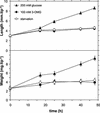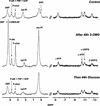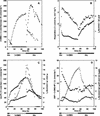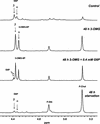In plants, 3-o-methylglucose is phosphorylated by hexokinase but not perceived as a sugar
- PMID: 12586906
- PMCID: PMC166858
- DOI: 10.1104/pp.010538
In plants, 3-o-methylglucose is phosphorylated by hexokinase but not perceived as a sugar
Abstract
In plants, sugars are the main respiratory substrates and important signaling molecules in the regulation of carbon metabolism. Sugar signaling studies suggested that sugar sensing involves several key components, among them hexokinase (HXK). Although the sensing mechanism of HXK is unknown, several experiments support the hypothesis that hexose phosphorylation is a determining factor. Glucose (Glc) analogs transported into cells but not phosphorylated are frequently used to test this hypothesis, among them 3-O-methyl-Glc (3-OMG). The aim of the present work was to investigate the effects and fate of 3-OMG in heterotrophic plant cells. Measurements of respiration rates, protein and metabolite contents, and protease activities and amounts showed that 3-OMG is not a respiratory substrate and does not contribute to biosynthesis. Proteolysis and lipolysis are induced in 3-OMG-fed maize (Zea mays L. cv DEA) roots in the same way as in sugar-starved organs. However, contrary to the generally accepted idea, phosphorous and carbon nuclear magnetic resonance experiments and enzymatic assays prove that 3-OMG is phosphorylated to 3-OMG-6-phosphate, which accumulates in the cells. Insofar as plant HXK is involved in sugar sensing, these findings are discussed on the basis of the kinetic properties because the catalytic efficiency of HXK isolated from maize root tips is five orders of magnitude lower for 3-OMG than for Glc and Man.
Figures








Similar articles
-
Mannose inhibits Arabidopsis germination via a hexokinase-mediated step.Plant Physiol. 1999 Mar;119(3):1017-23. doi: 10.1104/pp.119.3.1017. Plant Physiol. 1999. PMID: 10069839 Free PMC article.
-
Regulation of root ion transporters by photosynthesis: functional importance and relation with hexokinase.Plant Cell. 2003 Sep;15(9):2218-32. doi: 10.1105/tpc.013516. Plant Cell. 2003. PMID: 12953122 Free PMC article.
-
Plant Hexokinases are Multifaceted Proteins.Plant Cell Physiol. 2017 Jul 1;58(7):1151-1160. doi: 10.1093/pcp/pcx062. Plant Cell Physiol. 2017. PMID: 28449056 Review.
-
Regulation of protein degradation and protease expression by mannose in maize root tips. Pi sequestration by mannose may hinder the study of its signaling properties.Plant Physiol. 2001 Mar;125(3):1485-98. doi: 10.1104/pp.125.3.1485. Plant Physiol. 2001. PMID: 11244127 Free PMC article.
-
Sugar sensing and signaling in plants: conserved and novel mechanisms.Annu Rev Plant Biol. 2006;57:675-709. doi: 10.1146/annurev.arplant.57.032905.105441. Annu Rev Plant Biol. 2006. PMID: 16669778 Review.
Cited by
-
Glucose delays seed germination in Arabidopsis thaliana.Planta. 2004 Feb;218(4):579-88. doi: 10.1007/s00425-003-1154-9. Epub 2003 Nov 25. Planta. 2004. PMID: 14648119
-
Evidence for interindividual heterogeneity in the glucose gradient across the human red blood cell membrane and its relationship to hemoglobin glycation.Diabetes. 2008 Sep;57(9):2445-52. doi: 10.2337/db07-1820. Epub 2008 Jun 30. Diabetes. 2008. PMID: 18591386 Free PMC article.
-
A new substrate cycle in plants. Evidence for a high glucose-phosphate-to-glucose turnover from in vivo steady-state and pulse-labeling experiments with [13C]glucose and [14C]glucose.Plant Physiol. 2005 Aug;138(4):2220-32. doi: 10.1104/pp.105.062083. Epub 2005 Jul 15. Plant Physiol. 2005. PMID: 16024683 Free PMC article.
-
Differential regulation of glucose-6-phosphate dehydrogenase isoenzyme activities in potato.Plant Physiol. 2003 Sep;133(1):47-62. doi: 10.1104/pp.103.025676. Plant Physiol. 2003. PMID: 12970474 Free PMC article.
-
MondoA senses non-glucose sugars: regulation of thioredoxin-interacting protein (TXNIP) and the hexose transport curb.J Biol Chem. 2011 Nov 4;286(44):38027-38034. doi: 10.1074/jbc.M111.275503. Epub 2011 Sep 9. J Biol Chem. 2011. PMID: 21908621 Free PMC article.
References
-
- ap Rees T. Hexose phosphate metabolism by non-photosynthetic tissues of higher plants. In: Preiss J, editor. The Biochemistry of Plants. Vol. 14. New York: Academic Press; 1988. pp. 1–33.
-
- Axelos M, Curie C, Mazzolini L, Bardet C, Lescure B. A protocol for transient gene expression in Arabidopsis thaliana protoplasts isolated from cell suspension cultures. Plant Physiol Biochem. 1992;30:123–128.
-
- Bock K, Pedersen C. Carbon-13 nuclear magnetic resonance spectroscopy of monosaccharides. In: Tipson RS, Horton D, editors. Advances in Carbohydrates Chemistry and Biochemistry. New York: Academic Press; 1983. pp. 27–66.
-
- Bradford MM. A rapid and sensitive method for the quantification of microgram quantities of proteins utilizing the principle of protein-dye binding. Anal Biochem. 1976;72:248–254. - PubMed
Publication types
MeSH terms
Substances
LinkOut - more resources
Full Text Sources
Other Literature Sources

